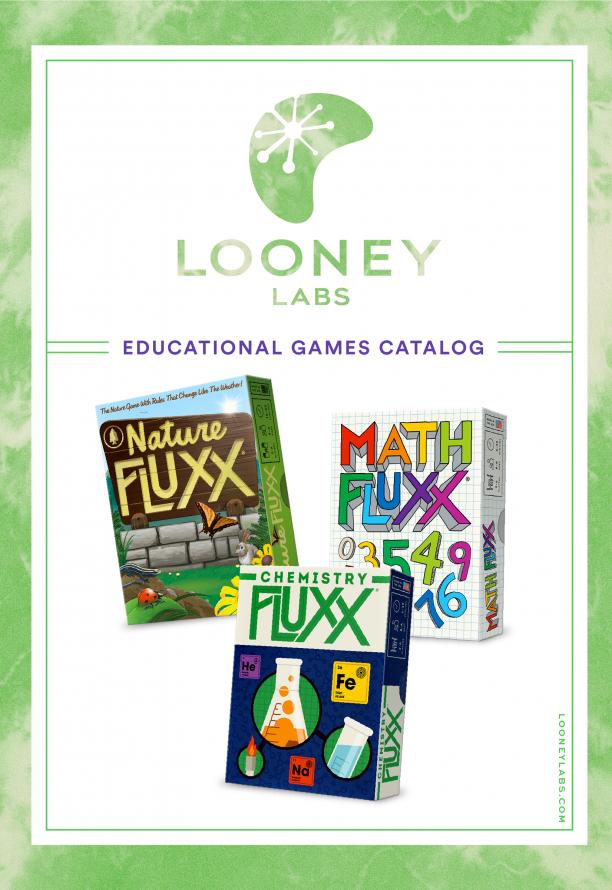
The catalog begins to explain the ways each of our games listed below can be used educationally, but we have many more details than can fit in this little catalog. Click on each game name listed (alphabetically) below to find more information on that game! Alternatively, you can also find out how we evaluated our games here.
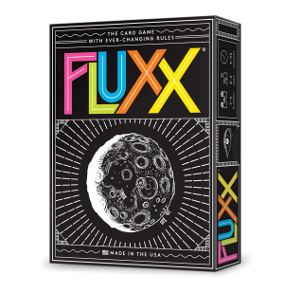
Game:
Time to Play:
Grade Levels:
Number of Players:
Educational Saturation Level:
Main Product Page:
Overview of Educational Benefits:
Because Fluxx is “the game of ever-changing rules,” it is an excellent “text” for encouraging close reading to determine what is said explicitly, to argue what can be logically inferred, and for citing specific text to support players’ conclusions. Fluxx is also often used in group settings focused on teaching social skills because it lends itself well to discussions about addressing different point of view, discussing differences politely, coming to consensus through discussion, and coping successfully with unknowns and constant change.
What Educators & Students Are Saying About This Game:
- Coming Soon!
Specific Ways to Use This Game in the Classroom:
- Coming Soon!
Primary Common Core Standards Addressed:
- R1 Read closely to determine what the text says explicitly and to make logical inferences from it; cite specific textual evidence when writing or speaking to support conclusions drawn from the text.
- SL1 Prepare for and participate effectively in a range of conversations and collaborations with diverse partners, building on others’ ideas and expressing their own clearly and persuasively.
- SL3 Evaluate a speaker’s point of view, reasoning, and use of evidence and rhetoric.
- SL4 Present information, findings, and supporting evidence such that listeners can follow the line of reasoning and the organization, development, and style are appropriate to task, purpose, and audience.
Specific Subject-Matter Content:
- Reading Comprehension
- Speaking & Listening
- Social Skills
Critical Thinking Development:
- CT1 Inquisitiveness, with a commitment to inquiry that is active, engaged, purposeful, disciplined, open-minded, and skillful.
- CT5 The ability to recognize relationships and connections, see relevance and significance, and understand context.
- CT10 The ability to clearly explain and communicate one’s thought processes so that others can comprehend.
- CT11 The ability to apply these critical thinking skills to real-world problems and everyday needs in the areas of decision-making, prioritization, and judgment.
- CT13 The ability to do all of the above efficiently, with a minimum of wasted time and effort.
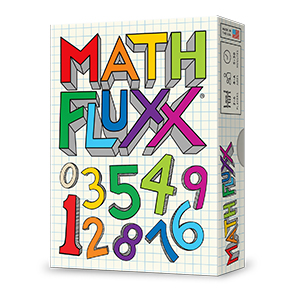
Name:
Time to Play:
Grade Levels:
Number of Players:
Educational Saturation Level:
Main Product Page:
Overview of Educational Benefits:
This version of Fluxx has all the educational benefits of the original Fluxx, and adds constant mental math practice using the four basic operations. In addition, it lightly introduces the ideas of place value, order of operations, factoring, prime and composite numbers, odd and even numbers, sequences, fractions, rounding, pi, and exponents (however, these concepts are not required to play the game).
What Educators & Students Are Saying About This Game:
- Coming Soon!
Specific Ways to Use This Game in the Classroom:
- Coming Soon!
Primary Common Core Standards Addressed:
- English-Language Arts standards R1, SL1, SL3, and SL4 (see Fluxx for details)
- Primary Mathematics Standards:
- 2.OA.2 Fluently add and subtract within 20 using mental strategies. By end of Grade 2, know from memory all sums of two one-digit numbers.
- 2.NBT.5 Fluently add and subtract within 100 using strategies based on place value, properties of operations, and/or the relationship between addition and subtraction.
- 3.OA.7 Fluently multiply and divide within 100, using strategies such as the relationship between multiplication and division (e.g., knowing that 8 x 5 = 40, one knows 40 / 5 = 8) or properties of operations. By the end of Grade 3, know from memory all products of two one-digit numbers.
- 4.OA.4 Find all factor pairs for a whole number in the range 1-100. Recognize that a whole number is a multiple of each of its factors. Determine whether a given whole number in the range 1-100 is a multiple of a given one-digit number. Determine whether a given whole number in the range 1-100 is prime or composite.
- 5.NBT.1 Recognize that in a multi-digit number, a digit in one place represents 10 times as much as it represents in the place to its right and 1/10 of what it represents in the place to its left.
- Other relevant Mathematics Standards include 1.OA.6, 1.NBT.2, 1.NBT.4, 1.NBT.5, 2.NBT.3, 2.NBT.7, 2.NBT.8, 2.NBT.9, 3.OA.5, 3.NBT.2, 3.NBT.3, 4.NBT.1, 4.NBT.2, 4.NBT.4, 4.NBT.5, 4.NBT.6, 5.OA.1, 5.NBT.2, 2.OA.3, 3.NF.1, 4.NBT.3, 5.NBT.4, 5.NF.6, 6.EE.1, 8.NS.1, and 8.EE.1
Specific Subject-Matter Content:
- 4 Operation Mental Math
- Introduction to Several More Advanced Concepts
- Reading Comprehension, Speaking & Listening, & Social Skills
Critical Thinking Development:
- CT1 Inquisitiveness, with a commitment to inquiry that is active, engaged, purposeful, disciplined, open-minded, and skillful.
- CT3 The ability to discover through experience, observation, reading, and listening a breadth and depth of knowledge that can inform critical thinking.
- CT5 The ability to recognize relationships and connections, see relevance and significance, and understand context.
- CT10 The ability to clearly explain and communicate one’s thought processes so that others can comprehend.
- CT11 The ability to apply these critical thinking skills to real-world problems and everyday needs in the areas of decision-making, prioritization, and judgment.
- CT13 The ability to do all of the above efficiently, with a minimum of wasted time and effort.
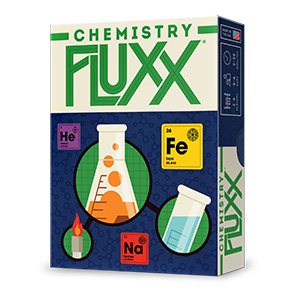
Name:
Time to Play:
Grade Levels:
Number of Players:
Educational Saturation Level:
Main Product Page:
Overview of Educational Benefits:
This version of Fluxx has all the educational benefits of the original Fluxx, and adds an introduction to the periodic table of elements and how those elements can be combined to create molecules and compounds. Elements are listed with their atomic number and their Bohr atomic model, and are color coded by type: alkaline earth metals, transition metals, noble gases, etc. Compounds are described by their chemical name, common name, and chemical formula.
What Educators & Students Are Saying About This Game:
- Coming Soon!
Specific Ways to Use This Game in the Classroom:
- Coming Soon!
Primary Common Core Standards Addressed:
- English-Language Arts standards R1, SL1, SL3, and SL4 (see Fluxx for details)
- Primary Literacy in Science and Technical Subjects Standards:
- RST.6-8.4, RST.9-10.4, & RST.11-12.4 Determine the meaning of symbols, key terms, and other domain-specific words and phrases as they are used in a specific scientific or technical context.
- RST.6-8.7 Integrate quantitative or technical information in words in a text with a version of that information expressed visually (e.g., in a flowchart, diagram, model, graph, or table).
- RST.11-12.9 Synthesize information from a range of sources (e.g., texts, experiments, simulations) into a coherent understanding of a process, phenomenon, or concept, resolving conflicting information when possible.
Specific Subject-Matter Content:
- Periodic Table of Elements
- Molecules and Compounds
- Reading Comprehension, Speaking & Listening, & Social Skills
Critical Thinking Development:
- CT1 Inquisitiveness, with a commitment to inquiry that is active, engaged, purposeful, disciplined, open-minded, and skillful.
- CT3 The ability to discover through experience, observation, reading, and listening a breadth and depth of knowledge that can inform critical thinking.
- CT5 The ability to recognize relationships and connections, see relevance and significance, and understand context.
- CT10 The ability to clearly explain and communicate one’s thought processes so that others can comprehend.
- CT11 The ability to apply these critical thinking skills to real-world problems and everyday needs in the areas of decision-making, prioritization, and judgment.
- CT13 The ability to do all of the above efficiently, with a minimum of wasted time and effort.
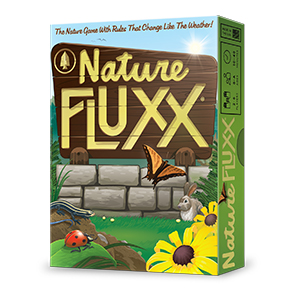
Name:
Time to Play:
Grade Levels:
Number of Players:
Educational Saturation Level:
Main Product Page:
Overview of Educational Benefits:
This version of Fluxx has all the educational benefits of the original Fluxx, and adds an introduction to the earth sciences. Players will learn about animal classification, beneficial adaptations (such as hibernation, pollination, and camouflage), the food web/chain, botany, geology, weather, and environmental conservation (such as recycling, composting, pollution, and extinction).
What Educators & Students Are Saying About This Game:
- Coming Soon!
Specific Ways to Use This Game in the Classroom:
- Coming Soon!
Primary Common Core Standards Addressed:
- English-Language Arts standards R1, SL1, SL3, and SL4 (see Fluxx for details)
- Primary Literacy in Science and Technical Subjects Standards:
- RST.6-8.2 Determine the central ideas or conclusions of a text; provide an accurate summary of the text distinct from prior knowledge or opinions.
- RST.6-8.5 Analyze the structure an author uses to organize a text, including how the major sections contribute to the whole and to an understanding of the topic.
- RST.6-8.9 Compare and contrast the information gained from experiments, simulations, video, or multimedia sources with that gained from reading a text on the same topic.
- RST.9-10.5 Analyze the structure of the relationships among concepts in a text, including relationships among key terms (e.g. force, friction, reaction force, energy).
Specific Subject-Matter Content:
- Earth Science
- Reading Comprehension, Speaking & Listening, & Social Skills
Critical Thinking Development:
- CT1 Inquisitiveness, with a commitment to inquiry that is active, engaged, purposeful, disciplined, open-minded, and skillful.
- CT3 The ability to discover through experience, observation, reading, and listening a breadth and depth of knowledge that can inform critical thinking.
- CT4 The ability to gather, organize, and synthesize that knowledge so as to create conceptual frameworks and viable generalizations.
- CT5 The ability to recognize relationships and connections, see relevance and significance, and understand context.
- CT10 The ability to clearly explain and communicate one’s thought processes so that others can comprehend.
- CT11 The ability to apply these critical thinking skills to real-world problems and everyday needs in the areas of decision-making, prioritization, and judgment.
- CT12 The ability to revise and reconstruct one’s beliefs, values, and actions based on the discernment gained through critical thinking so as to be more empathetic, ethical, democratic, even-handed, and successful.
- CT13 The ability to do all of the above efficiently, with a minimum of wasted time and effort.
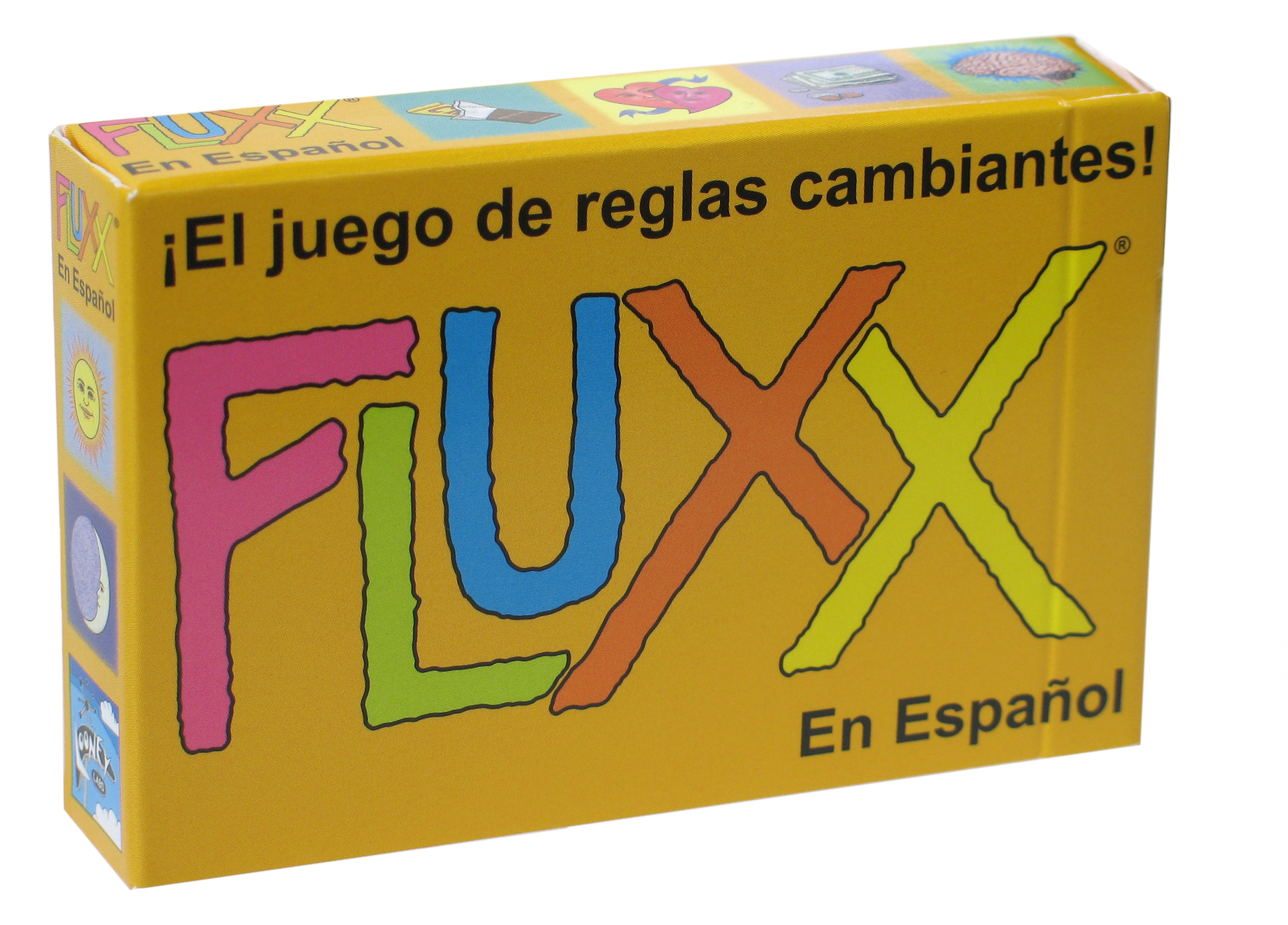
Name:
Time to Play:
Grade Levels:
Number of Players:
Educational Saturation Level:
Main Product Page:
Foreign Language Fluxxes
5-40 minutes
3-12+
2-6
5
Overview of Educational Benefits:
These versions of Fluxx have all the educational benefits of the original Fluxx, and do a great job of reinforcing instructional vocabulary in the target language. Fluxx is currently translated into ten different languages and more are coming soon. Excellent for both foreign language classes and for those learning English as a second language. We recommend starting by playing Fluxx in the student's first language until they are very familiar with the cards, then switching to the same version of Fluxx in the target language.
What Educators & Students Are Saying About This Game:
- Coming Soon!
Specific Ways to Use This Game in the Classroom:
- Coming Soon!
Primary ACTFL World-Readiness Standards for Learning Languages Addressed:
- Interpersonal Communication: Learners interact and negotiate meaning in spoken, signed, or written conversations to share information, reactions, feelings, and opinions.
- Interpretive Communication: Learners understand, interpret, and analyze what is heard, read, or viewed on a variety of topics.
- Language Comparisons: Learners use the language to investigate, explain, and reflect on the nature of language through comparisons of the language studied and their own.
Specific Subject-Matter Content:
- Second Language Acquisition
- Reading Comprehension, Speaking & Listening, & Social Skills
Critical Thinking Development:
- CT1 Inquisitiveness, with a commitment to inquiry that is active, engaged, purposeful, disciplined, open-minded, and skillful.
- CT3 The ability to discover through experience, observation, reading, and listening a breadth and depth of knowledge that can inform critical thinking.
- CT4 The ability to gather, organize, and synthesize that knowledge so as to create conceptual frameworks and viable generalizations.
- CT5 The ability to recognize relationships and connections, see relevance and significance, and understand context.
- CT6 The ability to use creativity, intuition, and imagination to view information from different perspectives, think in novel ways, and gain valuable insights.
- CT7 The ability to use deductive and inductive logic and reasoning to reach rational conclusions and interpretations of data.
- CT10 The ability to clearly explain and communicate one’s thought processes so that others can comprehend.
- CT11 The ability to apply these critical thinking skills to real-world problems and everyday needs in the areas of decision-making, prioritization, and judgment.
- CT13 The ability to do all of the above efficiently, with a minimum of wasted time and effort.
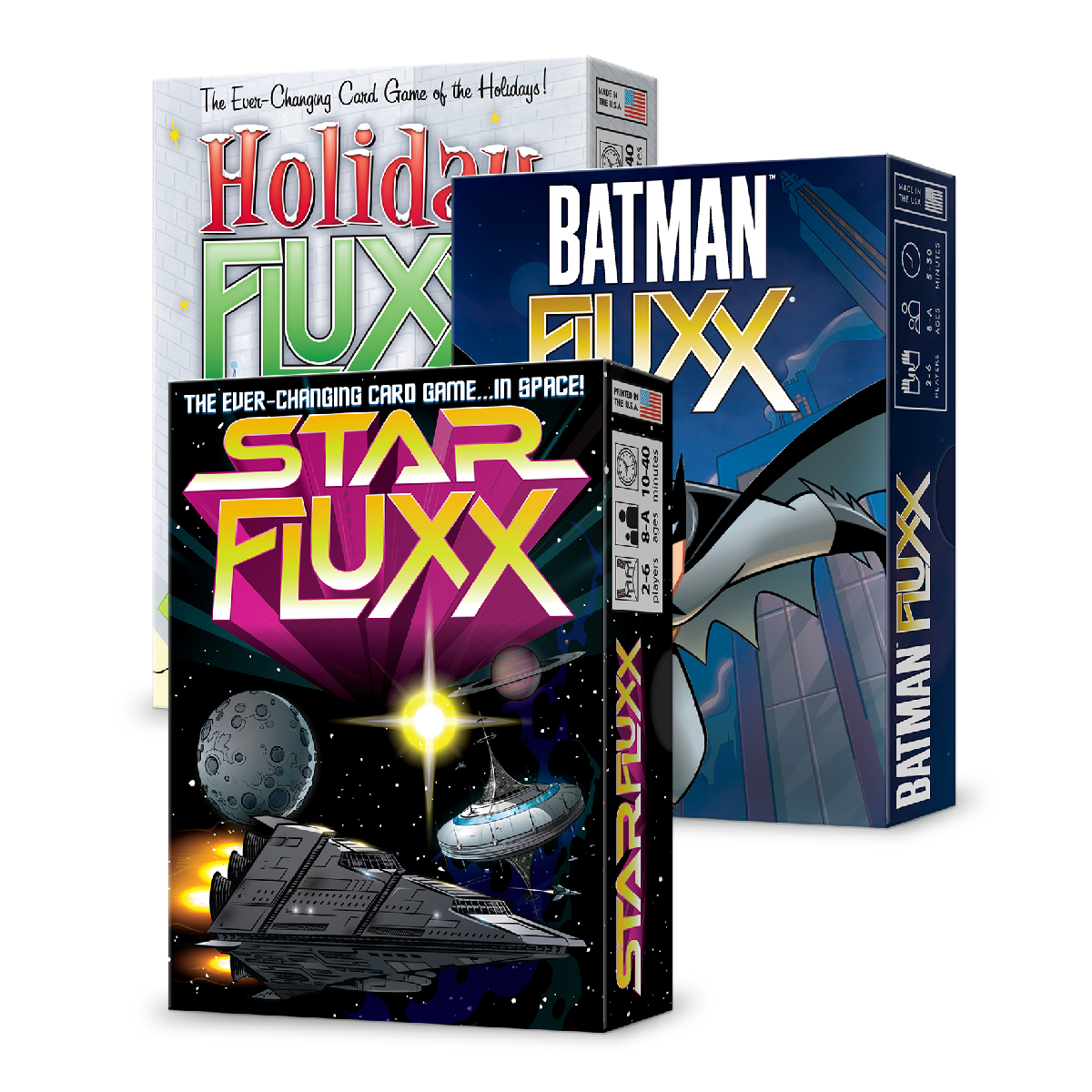
Name:
Time to Play:
Grade Levels:
Number of Players:
Educational Saturation Level:
Main Product Page:
Overview of Educational Benefits:
These versions of Fluxx have all the educational benefits of the original Fluxx, and offer an opportunity for literary analysis. Some Fluxx versions are based on actual literature (such as Frank Baum’s The Wizard of Oz and H.P. Lovecraft’s “The Call of Cthulhu”), while others are based on less traditional “texts,” such as TV shows (Batman, Firefly, Adventure Time, Regular Show), movies (Monty Python), pop culture (Star, Zombie, Pirate, Holiday, Monster) and bodies of non-fiction knowledge (Nature, Math, Chemistry). Regardless of the source “text,” Andrew Looney, in designing these games, has analyzed the central ideas and themes and their development and relation to one another, and summarized the key supporting details and ideas. Teachers can use these games to encourage student analysis of whether or not the game designer analyzed the key ideas in the text correctly. Students can also be encouraged to create a Fluxx deck of their own (and analyze a text in doing so) on a new topic.
What Educators & Students Are Saying About This Game:
- Coming Soon!
Specific Ways to Use This Game in the Classroom:
- Coming Soon!
Primary Common Core Standards Addressed:
- English-Language Arts standards R1, SL1, SL3, and SL4 (see Fluxx for details)
- R2 Determine central ideas or themes of a text and analyze their development; summarize the key supporting details and ideas.
- R3 Analyze how and why individuals, events, and ideas develop and interact over the course of a text.
- R4 Interpret words and phrases as they are used in a text, including determining technical, connotative, and figurative meanings, and analyze how specific word choices shape meaning or tone.
- R5 Analyze the structure of texts, including how specific sentences, paragraphs, and larger portions of the text (e.g., a section, chapter, scene, or stanza) relate to each other and the whole.
- R6 Assess how point of view or purpose shapes the content and style of a text.
- R9 Analyze how two or more texts address similar themes or topics in order to build knowledge or to compare the approaches the authors take.
- SL2 Integrate and evaluate information presented in diverse media and formats, including visually, quantitatively, and orally.
Specific Subject-Matter Content:
- Literature Analysis
- Reading Comprehension, Speaking & Listening, & Social Skills
Critical Thinking Development:
- CT1 Inquisitiveness, with a commitment to inquiry that is active, engaged, purposeful, disciplined, open-minded, and skillful.
- CT3 The ability to discover through experience, observation, reading, and listening a breadth and depth of knowledge that can inform critical thinking.
- CT4 The ability to gather, organize, and synthesize that knowledge so as to create conceptual frameworks and viable generalizations.
- CT5 The ability to recognize relationships and connections, see relevance and significance, and understand context.
- CT6 The ability to use creativity, intuition, and imagination to view information from different perspectives, think in novel ways, and gain valuable insights.
- CT10 The ability to clearly explain and communicate one’s thought processes so that others can comprehend.
- CT11 The ability to apply these critical thinking skills to real-world problems and everyday needs in the areas of decision-making, prioritization, and judgment.
- CT12 The ability to revise and reconstruct one’s beliefs, values, and actions based on the discernment gained through critical thinking so as to be more empathetic, ethical, democratic, even-handed, and successful.
- CT13 The ability to do all of the above efficiently, with a minimum of wasted time and effort.
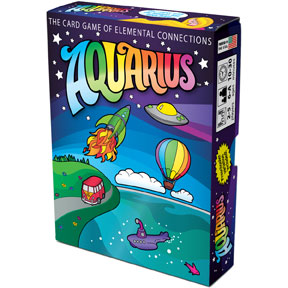
Name:
Time to Play:
Grade Levels:
Number of Players:
Educational Saturation Level:
Main Product Page:
Overview of Educational Benefits:
Though Aquarius is an enjoyable game for all ages, its educational value is primarily in the early elementary years. The rules sheet provides several variations on the game to adapt it to preschool and early elementary audiences. This game requires students to recognize colors, understand the concept of connectedness or proximity, use visual-spatial skills to place cards on the table correctly, and count numbers of connected cards. Teacher supervision is recommended for the first game or two, but this game soon becomes one that students can play on their own. If students are having difficulties with the skills involved, teachers may choose to first practice individual tasks such as sorting the cards by color, counting the cards when in a line or pile, counting them again when they are spread out, and matching two cards long side to long side or short side to short side so that the same colors are touching.
What Educators & Students Are Saying About This Game:
- Coming Soon!
Specific Ways to Use This Game in the Classroom:
- Coming Soon!
Primary Common Core Mathematics Standards Addressed:
- K.CC.4 Understand the relationship between numbers and quantities; connect counting to cardinality.
- K.CC.5 Count to answer “how many?” questions about as many as 20 things arranged in a line, a rectangular array, or a circle, or as many as 10 things in a scattered configuration; given a number from 1-20, count out that many objects.
- K.CC.6 Identify whether the number of objects in one group is greater than, less than, or equal to the number of objects in another group, e.g., by using matching and counting strategies.
- K.MD.3 Classify objects into given categories; count the numbers of objects in each category and sort the categories by count.
- K.G.1 Describe objects in the environment using names of shapes, and describe the relative positions of these objects using terms such as above, below, beside, in front of, behind, and next to.
Specific Subject-Matter Content:
- Classifying Colors
- Counting to 7
- Relative Position
- Visual Spatial Skills
Critical Thinking Development:
- CT5 The ability to recognize relationships and connections, see relevance and significance, and understand context.
- CT7 The ability to use deductive and inductive logic and reasoning to reach rational conclusions and interpretations of data.
- CT11 The ability to apply these critical thinking skills to real-world problems and everyday needs in the areas of decision-making, prioritization, and judgment.
- CT13 The ability to do all of the above efficiently, with a minimum of wasted time and effort.
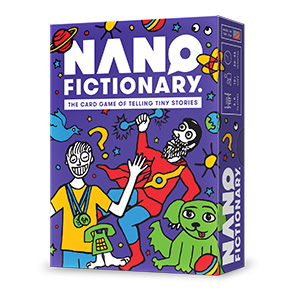
Name:
Time to Play:
Grade Levels:
Number of Players:
Educational Saturation Level:
Main Product Page:
Overview of Educational Benefits:
Though stories are shared orally in the core game, Nanofictionary is essentially a creative writing exercise. Students must collect cards in four “suits”—character, setting, problem, and resolution—that tell a cohesive short story. They must use their imaginations to connect the parts of their story in logical and entertaining ways, tell that story to the other players, listen to others’ stories, and evaluate each players’ level of success in telling a good story. The core game directly teaches the concepts of story elements and story development straight out of the box. Teachers may also choose to make this game available to individual students during creative writing periods as a means of generating story ideas and making sure all story elements are represented in their writing. Students may want to create additional customized cards to add to the deck, and there is an application available for doing so at Drive-Thru Cards.
What Educators & Students Are Saying About This Game:
- Coming Soon!
Specific Ways to Use This Game in the Classroom:
- Coming Soon!
Primary Common Core Standards Addressed:
- R2 Determine central ideas or themes of a text and analyze their development; summarize the key supporting details and ideas.
- R3 Analyze how and why individuals, events, and ideas develop and interact over the course of a text.
- R5 Analyze the structure of texts, including how specific sentences, paragraphs, and larger portions of the text (e.g., a section, chapter, scene, or stanza) relate to each other and the whole.
- R6 Assess how point of view or purpose shapes the content and style of a text.
- W3 Write narratives to develop real or imagined experiences or events using effective techniques, well-chosen details, and well-structured event sequences.
- W4 Produce clear and coherent writing in which the development, organization, and style are appropriate to task, purpose, and audience.
- W5 Develop and strengthen writing as needed by planning, revising, editing, rewriting, or trying a new approach.
- W10 Write routinely over extended time frames (time for research, reflection, and revision) and shorter time frames (a single sitting or a day or two) for a range of tasks, purposes, and audiences.
- SL3 Evaluate a speaker’s point of view, reasoning, and use of evidence and rhetoric.
- SL4 Present information, findings, and supporting evidence such that listeners can follow the line of reasoning and the organization, development, and style are appropriate to task, purpose, and audience.
- SL6 Adapt speech to a variety of contexts and communicative tasks, demonstrating command of formal English when indicated or appropriate.
Specific Subject-Matter Content:
- Elements of a story, including characters, settings, problems, and resolutions
Critical Thinking Development:
- CT3 The ability to discover through experience, observation, reading, and listening a breadth and depth of knowledge that can inform critical thinking.
- CT4 The ability to gather, organize, and synthesize that knowledge so as to create conceptual frameworks and viable generalizations.
- CT5 The ability to recognize relationships and connections, see relevance and significance, and understand context.
- CT6 The ability to use creativity, intuition, and imagination to view information from different perspectives, think in novel ways, and gain valuable insights.
- CT10 The ability to clearly explain and communicate one’s thought processes so that others can comprehend.
- CT13 The ability to do all of the above efficiently, with a minimum of wasted time and effort.
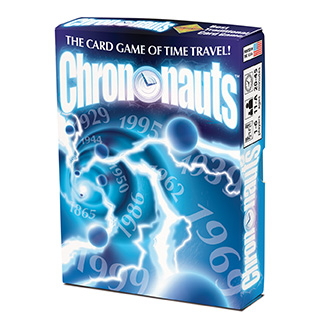
Name:
Time to Play:
Grade Levels:
Number of Players:
Educational Saturation Level:
Main Product Page:
Chrononauts & Early American Chrononauts
20-45 minutes
5-12+
1-6
3
looneylabs.com/games/chrononauts & http://www.looneylabs.com/games/early-american-chrononauts
Overview of Educational Benefits:
Chrononauts and Early American Chrononauts cover two segments of US history, but otherwise play the same. Both decks can be combined to play Uber Chrononauts. This game explores history both as it actually happened, and as it may have happened if “linchpin” events had not happened. Teachers may first want to have students examine the various game elements, such as the timeline, the patches, and the mission cards. The timeline can be laid out and examined to see what events in US history are included. A discussion can be had about why these events may have been chosen over others, and whether students feel any key events are missing. The reverse sides of the linchpin timeline cards can then be examined to see how the game designer envisioned things could have happened differently, such as what might have happened if Abraham Lincoln were not assassinated. Students can discuss why certain timeline cards are “linchpins,” whereas others are “ripple points.” The patch cards can then be examined to see how certain “linchpins” affect certain events in the future, and a discussion of the likelihood of such ripples actually happening may ensue. Finally, students can take a look at the mission cards, which group certain artifacts from history (real and imagined for comic effect). Students can discuss why a certain artifact collector from the future might want a particular grouping of artifacts. Spending time reviewing the cards in this way before playing can make the game more interesting and educational because it helps students see the connections.
Related activities that teachers may wish to assign include having students use a particular portion of the timeline to give a short talk about how events related to each other in that time frame, discussing “linchpins” and “ripple points” in other contexts (other eras of history, in literature, or in students’ personal lives), or having students work together to create their own timeline (complete with linchpins and ripple points) for other eras in history. Also note that there is a solitaire variant of this game included in the rules, so it could be played during quiet down times by individuals.
What Educators & Students Are Saying About This Game
- Coming Soon!
Specific Ways to Use This Game in the Classroom:
- Coming Soon!
Primary Common Core Standards Addressed:
- RH.6-8.2 Determine the central ideas or information of a primary or secondary source; provide an accurate summary of the source distinct from prior knowledge or opinions.
- RH.6-8.5 Describe how a text presents information (e.g., sequentially, comparatively, causally).
- RH.6-8.6 Identify aspects of a text that reveal an author’s point of view or purpose (e.g., loaded language, inclusion or avoidance of particular facts).
- RH.6-8.8 Distinguish among fact, opinion, and reasoned judgment in a text.
- RH.9-10.2 Determine the central ideas or information of a primary or secondary source; provide an accurate summary of how key events or ideas develop over the course of the text.
- RH.9-10.3 Analyze in detail a series of events described in a text; determine whether earlier events caused later ones or simply preceded them.
- RH.11-12.2 Determine the central ideas or information of a primary or secondary source; provide an accurate summary that makes clear the relationships among the key details and ideas.
- RH.11-12.9 Integrate information from diverse sources, both primary and secondary, into a coherent understanding of an idea or event, noting discrepancies among sources.
Specific Subject-Matter Content:
- Key Events in US History from 1770-1999
Critical Thinking Development:
- CT1 Inquisitiveness, with a commitment to inquiry that is active, engaged, purposeful, disciplined, open-minded, and skillful.
- CT2 A commitment to thoughtful and persistent metacognitive reflection with the aim of improving one’s thinking and self- regulation of that thinking.
- CT3 The ability to discover through experience, observation, reading, and listening a breadth and depth of knowledge that can inform critical thinking.
- CT4 The ability to gather, organize, and synthesize that knowledge so as to create conceptual frameworks and viable generalizations.
- CT5 The ability to recognize relationships and connections, see relevance and significance, and understand context.
- CT6 The ability to use creativity, intuition, and imagination to view information from different perspectives, think in novel ways, and gain valuable insights.
- CT7 The ability to use deductive and inductive logic and reasoning to reach rational conclusions and interpretations of data.
- CT8 The ability to systematically analyze and evaluate evidence and test hypotheses using appropriate methods, techniques, and criteria.
- CT9 The ability to recognize ambiguities, assumptions, biases, beliefs, distortions, errors, misinformation, prejudice, propaganda, self-deception, and subjectivity that may compromise accuracy and credibility.
- CT10 The ability to clearly explain and communicate one’s thought processes so that others can comprehend.
- CT11 The ability to apply these critical thinking skills to real-world problems and everyday needs in the areas of decision-making, prioritization, and judgment.
- CT12 The ability to revise and reconstruct one’s beliefs, values, and actions based on the discernment gained through critical thinking so as to be more empathetic, ethical, democratic, even-handed, and successful.
- CT13 The ability to do all of the above efficiently, with a minimum of wasted time and effort.
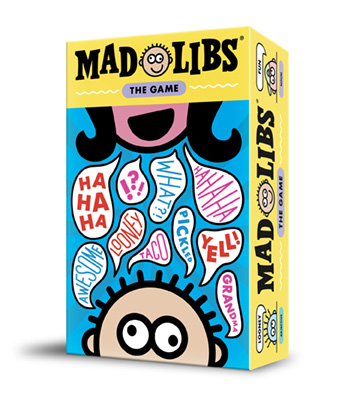
Name:
Time to Play:
Grade Levels:
Number of Players:
Educational Saturation Level:
Main Product Page:
Overview of Educational Benefits:
Mad Libs: The Game is an adaptation of the standard Mad Libs activity books, plays something like Apples to Apples, and is an excellent way to teach grammar in a fun and meaningful environment. Because the parts of speech are color-coded, students do not need to already know the parts of speech to play the game, but will naturally learn them as they play. A more formal discussion of nouns, verbs, adjectives, and adverbs may be included before or after play to ensure deeper understanding of what exactly each part of speech does in a sentence. Additionally, since only base words are included on the cards, students must adapt their words as needed to be plurals, use the correct article (a/an), make sure their nouns and verbs agree, and make the verb tense match the current sentence card. Each of these topics can be taught more formally as needed based on observation of trouble areas during gameplay. This game is also quite helpful for English Language Learners who are ready to learn the finer nuances of English. To test understanding of the parts of speech and further the fun, teachers may wish to have students create additional word cards for the game, stating the various forms of the word and each form’s part of speech.
What Educators & Students Are Saying About This Game:
- Coming Soon!
Specific Ways to Use This Game in the Classroom:
- Coming Soon!
Primary Common Core Standards Addressed:
- L1 Demonstrate command of the conventions of standard English grammar and usage when writing or speaking.
- L5 Demonstrate understanding of figurative language, word relationships, and nuances in word meanings.
Specific Subject-Matter Content:
- Parts of Speech, including nouns, verbs, adjectives, and adverbs
- Article-Noun Agreement
- Plural Nouns
- Noun-Verb Agreement
- Verb Tense
Critical Thinking Development:
- CT3 The ability to discover through experience, observation, reading, and listening a breadth and depth of knowledge that can inform critical thinking.
- CT4 The ability to gather, organize, and synthesize that knowledge so as to create conceptual frameworks and viable generalizations.
- CT5 The ability to recognize relationships and connections, see relevance and significance, and understand context.
- CT6 The ability to use creativity, intuition, and imagination to view information from different perspectives, think in novel ways, and gain valuable insights.
- CT13 The ability to do all of the above efficiently, with a minimum of wasted time and effort.
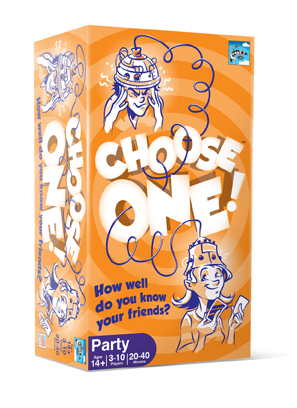
Name:
Time to Play:
Grade Levels:
Number of Players:
Educational Saturation Level:
Main Product Page:
Overview of Educational Benefits:
Choose One is not particularly educational in traditional senses, but is an excellent social skills game, as well as a great way for English Language Learners to make new friends while learning new vocabulary. In this game, students take turns choosing a card from their hand and playing it to the table. Each card has a choice of two things—maybe Batman vs. Superman, or pancakes vs. waffles, or camping vs. hotel. The student who played the card secretly indicates which one of the two items they prefer, while the remaining students secretly indicate their best guess as to which one the current player prefers. Secret indications are revealed and points are awarded for correct guesses, then the play passes to the left. This game encourages students to think from others’ points of view, consider what knowledge they have about their friends that may help them make correct guesses, and discuss reasons after the round is over so as to better get to know the players. When English Language Learners play with native English speakers, opportunities arise for vocabulary development on the part of the English Language Learner and for clearly defining vocabulary for the native speakers. If desired, teachers can end the session with a discussion of what new things were learned about their classmates, strategies for guessing correctly, and what choices were hard to make and why.
What Educators & Students Are Saying About This Game:
- Coming Soon!
Specific Ways to Use This Game in the Classroom:
- Coming Soon!
Primary Common Core Standards Addressed:
- SL1 Prepare for and participate effectively in a range of conversations and collaborations with diverse partners, building on others’ ideas and expressing their own clearly and persuasively.
- SL4 Present information, findings, and supporting evidence such that listeners can follow the line of reasoning and the organization, development, and style are appropriate to task, purpose, and audience.
- L6 Acquire and use accurately a range of general academic and domain-specific words and phrases sufficient for reading, writing, speaking, and listening at the college and career readiness level; demonstrate independence in gathering vocabulary knowledge when encountering an unknown term important to comprehension or expression.
Specific Subject-Matter Content:
- This game is good for groups practicing social skills, such as turn taking, perspective taking, and tolerance of differences.
- This game is good for English Language Learners because it encourages vocabulary development and friendship development.
Critical Thinking Development:
- CT1 Inquisitiveness, with a commitment to inquiry that is active, engaged, purposeful, disciplined, open-minded, and skillful.
- CT2 A commitment to thoughtful and persistent metacognitive reflection with the aim of improving one’s thinking and self- regulation of that thinking.
- CT3 The ability to discover through experience, observation, reading, and listening a breadth and depth of knowledge that can inform critical thinking.
- CT4 The ability to gather, organize, and synthesize that knowledge so as to create conceptual frameworks and viable generalizations.
- CT5 The ability to recognize relationships and connections, see relevance and significance, and understand context.
- CT6 The ability to use creativity, intuition, and imagination to view information from different perspectives, think in novel ways, and gain valuable insights.
- CT7 The ability to use deductive and inductive logic and reasoning to reach rational conclusions and interpretations of data.
- CT9 The ability to recognize ambiguities, assumptions, biases, beliefs, distortions, errors, misinformation, prejudice, propaganda, self-deception, and subjectivity that may compromise accuracy and credibility.
- CT10 The ability to clearly explain and communicate one’s thought processes so that others can comprehend.
- CT11 The ability to apply these critical thinking skills to real-world problems and everyday needs in the areas of decision-making, prioritization, and judgment.
- CT12 The ability to revise and reconstruct one’s beliefs, values, and actions based on the discernment gained through critical thinking so as to be more empathetic, ethical, democratic, even-handed, and successful.
- CT13 The ability to do all of the above efficiently, with a minimum of wasted time and effort.
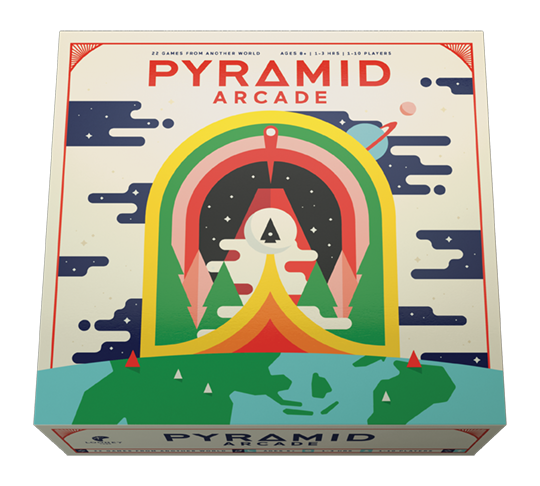
Name:
Time to Play:
Grade Levels:
Number of Players:
Educational Saturation Level:
Main Product Page:
Overview of Educational Benefits:
Pyramid Arcade is a library of 22 games, with a wide variety of age levels, difficulty levels, and types of play (such as “king of the hill,” “press your luck,” “perfect information,” and “manual dexterity” games). Some of these games address common core standards, particularly in the realm of early-elementary math skills and middle-school level probability puzzles. Some of the games can be played by kindergarteners, others are strategy games that can take years of study and strong critical thinking skills to master. What they all have in common is that they use a beautiful set of 90 plastic pyramids, and that they are excellent tools for building critical thinking skills. Though relatively expensive, this set offers a range of games that can keep an entire classroom engaged for hours using just the one box. It can also keep a kindergartener and high school senior equally challenged and excited to play. This boxed set is perfect for homeschool libraries, after-school programs, and STEM clubs, as well as for use in standard classrooms.
What Educators & Students Are Saying About This Game:
Coming Soon!
Specific Ways to Use This Game in the Classroom:
Coming Soon!
Primary Common Core Mathematics Standards Addressed (specific games meeting these standards are listed at the end of each standard):
- K.MD.2 Directly compare two objects with a measurable attribute in common, to see which object has “more of”/“less of” the attribute, and describe the difference. (Color Wheel)
- K.MD.3 Classify objects into given categories; count the numbers of objects in each category and sort the categories by count. (Color Wheel)
- K.G.1 Describe objects in the environment using names of shapes, and describe the relative positions of these objects using terms such as above, below, beside, in front of, behind, and next to. (Color Wheel, Looney Ludo, Twin Win)
- K.CC.5 Count to answer “how many?” questions about as many as 20 things arranged in a line, a rectangular array, or a circle, or as many as 10 things in a scattered configuration; given a number from 1-20, count out that many objects. (Color Wheel, Looney Ludo, Pharaoh, Verticality)
- K.CC.6 Identify whether the number of objects in one group is greater than, less than, or equal to the number of objects in another group, e.g., by using matching and counting strategies. (Looney Ludo, Pharaoh, Verticality)
- K.OA.1 Represent addition and subtraction with objects, fingers, mental images, drawings, sounds (e.g., claps), acting out situations, verbal explanations, expressions, or equations. (Looney Ludo, Pharaoh)
- K.OA.3 Decompose numbers less than or equal to 10 into pairs in more than one way, e.g., by using objects or drawings, and record each decomposition by a drawing or equation (e.g., 5 = 2 + 3 and 5 = 4 + 1). (Pharaoh, Pyramid-Sham-Bo)
- K.OA.5 Fluently add and subtract within 5. (Pharaoh, Pyramid-Sham-Bo)
- 1.OA.5 Relate counting to addition and subtraction (e.g., by counting on 2 to add 2). (Pyramid-Sham-Bo)
- 1.OA.6 Add and subtract within 20, demonstrating fluency for addition and subtraction within 10. Use strategies such as counting on; making ten (e.g., 8 + 6 = 8 + 2 + 4 = 10+ 4 = 14); decomposing a number leading to a ten (e.g., 13 - 4 = 13 - 3 - 1 = 10 - 1 = 9); using the relationship between addition and subtraction (e.g., knowing that 8 + 4 = 12, one knows 12 - 8 = 4); and creating equivalent but easier or known sums (e.g., adding 6 + 7 by creating the know equivalent 6 + 6 + 1 = 12 + 1 = 13). (World War 5)
- 2.NBT.5 Fluently add and subtract within 100 using strategies based on place value, properties of operations, and/or the relationship between addition and subtraction. (Ice Towers, Martian Chess)
- 7.SP.5 Understand that the probability of a chance event is a number between 0 and 1 that expresses the likelihood of the event occurring. Larger numbers indicate greater likelihood. A probability near 0 indicates an unlikely event, a probability around 1/2 indicates an event that is neither unlikely nor likely, and a probability near 1 indicates a likely event. (Black ICE, Give or Take, Hijinks, Ice Dice, Looney Ludo, Pharaoh, Powerhouse, Treehouse, World War 5)
- 7.SP.6 Approximate the probability of a chance event by collecting data on the chance process that produces it and observing its long-run relative frequency, and predict the approximate relative frequency given the probability. (Black ICE, Give or Take, Hijinks, Ice Dice, Looney Ludo, Pharaoh, Powerhouse, Treehouse, World War 5)
- 7.SP.7 Develop a probability model and use it to find probabilities of events. Compare probabilities from a model to observed frequencies; if the agreement is not good, explain possible sources of the discrepancy. (Black ICE, Give or Take, Hijinks, Ice Dice, Looney Ludo, Pharaoh, Powerhouse, Treehouse, World War 5)
- 7.SP.8 Find probabilities of compound events using organized lists, tables, tree diagrams, and simulation. (Black ICE, Ice Dice, Looney Ludo, Pharaoh, World War 5)
Specific Subject-Matter Content:
- Compare and Classify Objects
- Relative Positions
- Counting
- Greater Than, Less Than
- Adding at a variety of different levels
- Visual-Spatial and Visual-Tactile Skills
- Very Basic Geography (Continents)
- Probability of both simple and compound events
Critical Thinking Development:
- CT1 Inquisitiveness, with a commitment to inquiry that is active, engaged, purposeful, disciplined, open-minded, and skillful.
- CT2 A commitment to thoughtful and persistent metacognitive reflection with the aim of improving one’s thinking and self- regulation of that thinking.
- CT3 The ability to discover through experience, observation, reading, and listening a breadth and depth of knowledge that can inform critical thinking.
- CT4 The ability to gather, organize, and synthesize that knowledge so as to create conceptual frameworks and viable generalizations.
- CT5 The ability to recognize relationships and connections, see relevance and significance, and understand context.
- CT6 The ability to use creativity, intuition, and imagination to view information from different perspectives, think in novel ways, and gain valuable insights.
- CT7 The ability to use deductive and inductive logic and reasoning to reach rational conclusions and interpretations of data.
- CT8 The ability to systematically analyze and evaluate evidence and test hypotheses using appropriate methods, techniques, and criteria.
- CT9 The ability to recognize ambiguities, assumptions, biases, beliefs, distortions, errors, misinformation, prejudice, propaganda, self-deception, and subjectivity that may compromise accuracy and credibility.
- CT10 The ability to clearly explain and communicate one’s thought processes so that others can comprehend.
- CT11 The ability to apply these critical thinking skills to real-world problems and everyday needs in the areas of decision-making, prioritization, and judgment.
- CT12 The ability to revise and reconstruct one’s beliefs, values, and actions based on the discernment gained through critical thinking so as to be more empathetic, ethical, democratic, even-handed, and successful.
- CT13 The ability to do all of the above efficiently, with a minimum of wasted time and effort.

Name:
Time to Play:
Grade Levels:
Number of Players:
Educational Saturation Level:
Main Product Page:
Zendo
15-60 minutes
K-3 (modified), 4-12+
3-6
5
Not Yet Available
Overview of Educational Benefits:
Zendo is a game of inductive reasoning that relies heavily on concepts about three-dimensional shapes and on critical thinking. Zendo is an exemplary game for building critical thinking skills, and the rules offer quite a bit of advice for how to improve thinking skills over time.
For the early elementary grades, Zendo pieces can be used for building, sorting, and exploring. Teachers can discuss all the different attributes the pieces may have, how the pieces are similar and different, and may play simpler attribute games with the pieces.
What Educators & Students Are Saying About This Game:
- Coming Soon!
Specific Ways to Use This Game in the Classroom:
- Coming Soon!
Primary Common Core Mathematics Standards Addressed:
- K.CC.5 Count to answer “how many?” questions about as many as 20 things arranged in a line, a rectangular array, or a circle, or as many as 10 things in a scattered configuration; given a number from 1-20, count out that many objects.
- K.CC.6 Identify whether the number of objects in one group is greater than, less than, or equal to the number of objects in another group, e.g., by using matching and counting strategies.
- K.MD.1 Describe measurable attributes of objects, such as length or weight. Describe several measurable attributes of a single object.
- K.MD.3 Classify objects into given categories; count the numbers of objects in each category and sort the categories by count.
- K.G.1 Describe objects in the environment using names of shapes, and describe the relative positions of these objects using terms such as above, below, beside, in front of, behind, and next to.
- K.G.2 Correctly name shapes regardless of their orientations or overall size.
- K.G.3 Identify shapes as two-dimensional (lying in a plane, “flat”) or three-dimensional (“solid”).
- K.G.4 Analyze and compare two- and three-dimensional shapes, in different sizes and orientations, using informal language to describe their similarities, differences, parts (e.g., number of sides and vertices / “corners”) and other attributes (e.g., having sides of equal length).
- K.G.6 Compose simple shapes to form larger shapes.
- 1.G.1 Distinguish between defining attributes (e.g., triangles are closed and three-sided) versus non-defining attributes (e.g., color, orientation, overall size); build and draw shapes to possess defining attributes.
- 1.G.2 Compose two-dimensional shapes (rectangles, squares, trapezoids, triangles, half-circles, and quarter-circles) or three- dimensional shapes (cubes, right rectangular prisms, right circular cones, and right circular cylinders) to create a composite shape, and compose new shapes from the composite shape.
- 2.G.1 Recognize and draw shapes having specified attributes, such as a given number of angles or a given number of equal faces. Identify triangles, quadrilateral, pentagons, hexagons, and cubes.
- 3.G.1 Understand that shapes in different categories (e.g., rhombuses, rectangles, and others) may share attributes (e.g., having four sides), and that the shared attributes can define a larger category (e.g., quadrilaterals). Recognize rhombuses, rectangles, and squares as examples of quadrilaterals, and draw examples of quadrilaterals that do not belong to any of these subcategories.
- 4.OA.5 Generate a number or shape pattern that follows a given rule. Identify apparent features of the pattern that were not explicit in the rule itself.
- 6.G.4 Represent three-dimensional figures using nets made up of rectangles and triangles, and use the nets to find the surface area of these figures. Apply these techniques in the context of solving real-word and mathematical problems.
- 7.G.3 Describe the two-dimensional figures that result from slicing three-dimensional figures, as in plane sections of right rectangular prisms and right rectangular pyramids.
Specific Subject-Matter Content:
- Three-Dimensional Objects (right rectangular prisms, right rectangular pyramids, and right triangular prisms)
- Attributes and Features, including color, shape, number, orientation, relative position, sides, faces, vertices, height, open/closed, etc.
- Recognizing Patterns and Shared Attributes
- Creating Composite Shapes from Basic Shapes
Critical Thinking Development:
- CT1 Inquisitiveness, with a commitment to inquiry that is active, engaged, purposeful, disciplined, open-minded, and skillful.
- CT2 A commitment to thoughtful and persistent metacognitive reflection with the aim of improving one’s thinking and self- regulation of that thinking.
- CT3 The ability to discover through experience, observation, reading, and listening a breadth and depth of knowledge that can inform critical thinking.
- CT4 The ability to gather, organize, and synthesize that knowledge so as to create conceptual frameworks and viable generalizations.
- CT5 The ability to recognize relationships and connections, see relevance and significance, and understand context.
- CT6 The ability to use creativity, intuition, and imagination to view information from different perspectives, think in novel ways, and gain valuable insights.
- CT7 The ability to use deductive and inductive logic and reasoning to reach rational conclusions and interpretations of data.
- CT8 The ability to systematically analyze and evaluate evidence and test hypotheses using appropriate methods, techniques, and criteria.
- CT9 The ability to recognize ambiguities, assumptions, biases, beliefs, distortions, errors, misinformation, prejudice, propaganda, self-deception, and subjectivity that may compromise accuracy and credibility.
- CT10 The ability to clearly explain and communicate one’s thought processes so that others can comprehend.
- CT11 The ability to apply these critical thinking skills to real-world problems and everyday needs in the areas of decision-making, prioritization, and judgment.
- CT12 The ability to revise and reconstruct one’s beliefs, values, and actions based on the discernment gained through critical thinking so as to be more empathetic, ethical, democratic, even-handed, and successful.
- CT13 The ability to do all of the above efficiently, with a minimum of wasted time and effort.


